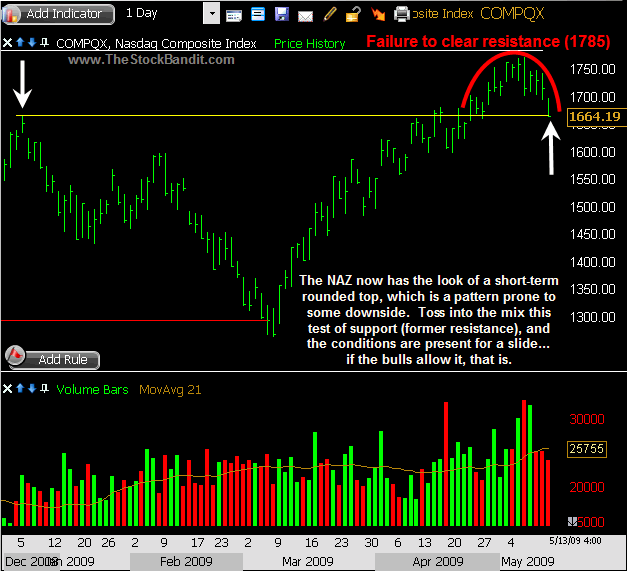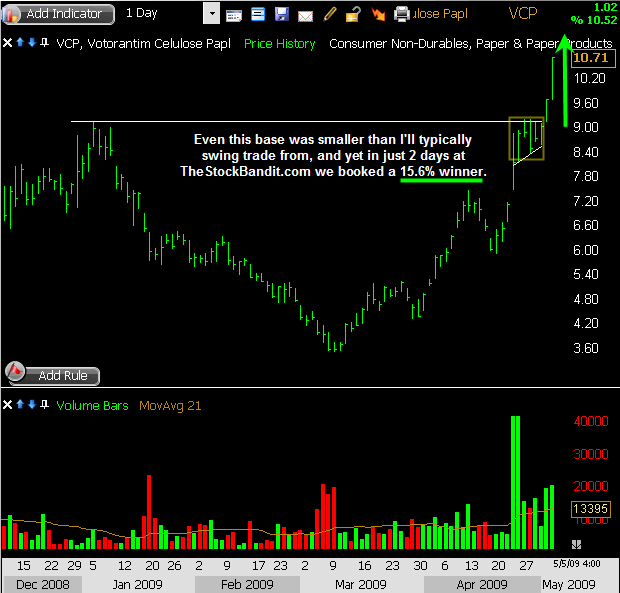 Archive for May, 2009
Archive for May, 2009
Lessons from My Biggest Trading Loss
May 28, 2009 at 9:58 am
 The trading has been really, really good lately. I’ve been fortunate to nail some nice moves for both day trading and swing trading timeframes, which of course is always fun.
The trading has been really, really good lately. I’ve been fortunate to nail some nice moves for both day trading and swing trading timeframes, which of course is always fun.
But in order to recognize and appreciate the good times, one must also go through some periods of poor performance. You have to struggle, and fight through the pain. Expensive lessons get learned, and thank goodness, they can stay with you for a while.
That’s what I’m here to tell you about in this post.
I want to show you some lessons I learned from the biggest trading loss I ever took, and hopefully you’ll benefit from my mistakes. After all, standing on someone else’s shoulders is the best way to look forward.
Setting the Scene
With summertime having arrived in 2004, the usual conditions were present. That means lighter trading volume – and whenever that’s the case, I tend to prefer short selling over buying. (I view volume as the fuel needed to propel a stock higher, so when it’s present, I realize bidders can simply disappear and the stock can slide without needing high activity.)
Having noticed a deep correction in NVTL which shaved off about 1/2 its value in just a few weeks, I had the stock on the radar and was waiting for a good setup. No harm so far.
It had begun a lazy, light-volume bounce off its correction low, which of course left me skeptical. I watched for the pace of the bounce to slow, and once it did, I started a position. That was on June 1 as it attemped to roll over slightly, but it was merely an attempt.
The following day, NVTL made a new recovery high, but I stayed in the position. Mistake #1. As soon as the bounce resumed, that was grounds for dismissal, but I stuck around in a stubborn fashion. A week later, NVTL was again on the move, and I found my P&L turning deeper red by the day.
I was wrong, and it hurt. So I did what any trader in the midst of breaking trading rules would do – I added to my position. Mistake #2. Now I’m in a bad trade and I have too much of it. Why? Because I needed to be right. Mistake #3.

StockFinder Chart courtesy of Worden
Long story short, after adding a couple of times on the way up to improve my basis, I ultimately drew a line in the sand which was crossed 3 weeks after my entry. I blew out of the trade… stunned, bruised, and yet relieved.
Ultimately NVTL corrected, but I would have had to hold the position for another month and endure another 10% against me before that happened. Even then, I only would have been able to exit at breakeven.
It was a nasty loss, and it angered me to have allowed it. Now 5 years later, I still shake my head at the series of mistakes I made, but it’s a great reminder to me of what can happen when I allow myself to break my rules.
Reminders & Takeaways
- “Paper” losses are very real. Many try to fool themselves into thinking that because a gain or loss hasn’t been realized, that it should be viewed differently. Wrong. If you’re underwater in a position, you’re losing whether it’s a closed or open position.
- Adding to losing trades is a recipe for pain. If you’re already in the hole and you’re already in the size of position you originally intended to be in, you stand to dig a deeper hole and cloud your judgment even more. Don’t add to a losing position when it’s a hail-mary effort at escaping a bad trade.
- Accepting a big loss can bring about some needed relief. For one, you’re ending the loss – it can get no worse. That’s a big reduction of stress and distractions from your other trading efforts, which is a huge benefit. You’re also accepting that you were wrong, and creating some closure which mentally helps you move on. There’s no substitute for a clear head when trading, so take it. Further, there are few things worse than logging into your trading platform and staring at a giant loser day after day.
- Being early = being wrong. This trade ultimately moved back in the direction I thought it would, but not until it had far exceeded my “uncle” point. Just goes to show that the market can continue moving against you for longer than you can handle it sometimes, so it’s never worth arguing with.
If I could get away with only talking about my great trades here, it might be more enjoyable for me, but you’d take less away from it as a reader.
And the reality is that I lose on plenty of trades. But there is much to be gleaned from glancing in that rearview mirror, both for me and for you. That’s how we get better!
Sometimes it comes with a grin and sometimes with a grimace, but it always offers valuable lessons to gain from. I hope you’re willing to do the same with your own trades.
Are you watching the Trading Videos over at TheStockBandit.TV?
Jeff White
President, The Stock Bandit, Inc.
Swing Trading & Day Trading Service
www.TheStockBandit.com
[tags]Stock Market, Day Trading, Stock Trading, Investing, Swing Trading[/tags]
Clues to Observe for a Market Correction
May 26, 2009 at 8:07 am
 Is this market due for a correction?
Is this market due for a correction?
That’s the million-dollar question right now for many, so why don’t we examine a few clues to watch for just in case. After all, there could be some hints provided by the market before the heavy selling hits – that is, if it’s coming.
Here are 3 technical considerations I’m going to be on the lookout for…
- Weak closes. These tend to signal that some distribution is taking place. We’re all familiar with the phrase “amateurs open the market and pro’s close it,” but I think there really is something to the way in which the market closes. If it’s limping across the finish line with any regularity, it’s usually a sign of at least some short-term fatigue and therefore ripe for some selling.
- Watch key support and resistance levels. If key resistance is turning the averages away or if support levels are breaking, that’s ample proof of some underlying selling. (I highlight these weekly in the Market View videos over at TheStockBandit.TV.)
- Watch for potential lower highs and/or lower lows to be created. While these may take some time to actually confirm, keeping tabs on stalling rallies and areas where bounces look to be failing is a telltale sign that the buyers aren’t in charge.
There are probably several more, but those are the ways I tend to gauge the underlying market strength and weakness. Some traders prefer to watch indicators or sentiment readings, but monitoring the price action and the character of market moves tends to provide enough clues for me.
One other thought… I do flip through several hundred individual stock charts nightly, and that also helps me gauge whether more stocks are acting strong, weak, or are just lethargic. It also helps me determine when to curb my buying. So if you don’t currently use a charting program that enables you to keep watch lists, make notes, and draw trend lines, then get one!
And you know, even if this market does end up correcting a bit, what would be so bad about that?
Jeff White
President, The Stock Bandit, Inc.
Swing Trading & Day Trading Service
www.TheStockBandit.com
[tags]Stock Market, Day Trading, Stock Trading, Investing, Swing Trading[/tags]
We Now Interrupt Your Normal Programming
May 14, 2009 at 7:21 am

Perhaps the automatic buy button got disconnected somehow, but Wednesday’s decline marked the 3rd consecutive decline in as many days – something we’ve not seen since early March when this market caught fire for 9 very green weeks.
And although a 3-day losing streak is far from the worst thing this market could see, it begs the question of whether or not it’s the beginning of, um… a change of character.
A short-term turnaround.
Ok, a reversal, to put it bluntly.
After all, a pullback is going to happen eventually which lasts for a few weeks – not just a few days, and now might be just as good a time as any for that to happen.
No Crystal Ball
Now, I’m not one to make big bold predictions, but some of you might recall that on the day of the low in March – yes, 9 weeks ago – I showed you right here the “technical threat of a short-term reversal.” I wasn’t going out on a limb, just calling it as I saw it.
It turned out pretty well.
So here I am again, simply pointing out what I see.
And if this does prove to be the early portion of the first meaningful pullback we’ve seen since early March, it’s important to first recognize that it would be a healthy event. The strongest markets do have pullbacks along the way, and that actually can help to perpetuate a trend.
Think of it like a rest – nobody can run nonstop forever, and the market is the same way. Some time on the bench can be a good thing.
Winds of Short-Term Change
This question of whether conditions are shifting or not is at the forefront of the discussion right now. Most individual stocks will take their cues from “the market,” which is developing a bit of a rolled-over appearance on the daily charts here, I might add. Stated otherwise, it might play out to be more than merely a 3-day dip, with a pretty big if. (See the caption on the chart below.)

StockFinder Chart courtesy of Worden
3 Positives of a Pullback
And so it may very well be that a decent correction is finally starting here, which if it does, could serve to do a number of things – all of which are good. Assuming we don’t go straight back to the March low, that is. Here they are:
1. The widespread overbought conditions we’ve seen for the past several weeks can finally go away. That means when a bullish setup appears, it’s less likely to need a “stay away” sign in front of it for those of us who prefer to manage our risk accordingly.
2. Stocks should (once a good pullback is completed) be able to set up some new bases, patterns, and support zones for trading. While this might take more than just a few days, it’s ultimately great news – especially if your preferred timeframe is swing trading. The stocks which have produced nothing but steady climbs without rest can finally pull back and establish some new support – like a higher low. Combined with the higher highs we’ve already seen in recent weeks, that would keep the uptrend intact.
3. A meaningful pullback is going to help separate the men from the boys. During this run from the March lows, few stocks have failed to participate. It’s almost like everybody’s doing it. It seems virtually everything has joined in the rally, making it difficult to determine which stocks are merely being squeezed higher and which ones are developing into true, lasting leaders. Separating the also-rans from real leadership should help to narrow our focus as traders, and give us higher quality plays on both sides of the tape. That’s something we all stand to benefit from, whether bull or bear.
So in closing, let me just say I’m no perma-bear. But don’t hate me if I’m rooting for a little more of a correction here. It sure doesn’t have to last forever, and I think it’ll lead to much better things for those of us trading this market.
Jeff White
President, The Stock Bandit, Inc.
Swing Trading & Day Trading Service
www.TheStockBandit.com
[tags]Stock Market, Day Trading, Stock Trading, Investing, Swing Trading[/tags]
Testing 1-2-3
May 12, 2009 at 7:17 am

I’ve written before about my opinion of backtesting, but let’s go a different direction here and talk about just plain-Jane testing.
If you were told that a diet pill would have you in that beach body by June, you’d probably be skeptical. But given enough evidence, you just might try it. Tentatively.
We’re no different in our trading. Those of us who trade daily, who observe the price action and who are truly students of the market will on a regular basis run across something of interest. Maybe it’s a routine in the overall market (such as early strength or late-day weakness) that seems to provide an opportunity. Or perhaps it’s a setup that’s been producing some phenomenal moves.
Whatever ‘it’ happens to be, the odds are that you’re initially intrigued by it but yet reluctant to really go for it and trust it.
Why that is, I don’t know. Human nature I suppose. But regardless, when we do identify that anomoly which could quickly prove profitable for us as traders, we have to find out if it’s legit.
Enter: the test.
Let’s suppose your standard trade size is, oh, 1000 shares. Or maybe it’s $20,000 per position. However you define your standard position size, throw that out the window when it comes to testing a brand new trade idea.
Because the first time you do it, even the 5th time you do it, it’s not about making money. It’s all about gaining some insights into how that idea plays out. It’s about getting a feel for how it acts. It’s about building a little confidence in that setup before you go for it for realz.
So cut that size down by, oh…90%. I’m saying take 10% of your standard size and give that trade a shot.
Trade it so small that you won’t feel it – win or lose. Because remember, the point is to start getting a feel for how it might go. Removing the risk we all feel which is tied to performance is crucial in the testing phase, so that’s a necessity. Trade tiny and see what happens.
As you start to gather a little data and see some ways you might improve on entry, exit, or timing, then you’re getting closer. And again, you most likely haven’t made or lost much at all during this test process – because that isn’t the point. Just feel it out, evaluate the info which comes back to you, and adjust.
Then, once you’ve got it down and have developed a more sound methodology for putting on and taking off that trade, only then is it time to step up the size. And then have at it, because that’s the point at which it’s about making money.
Anything prior to that is merely a test.
Jeff White
President, The Stock Bandit, Inc.
Swing Trading & Day Trading Service
www.TheStockBandit.com
[tags]Stock Market, Day Trading, Stock Trading, Investing, Swing Trading[/tags]
Profiting from Market Changes
May 6, 2009 at 9:12 am
It’s a strong tape – there is no doubt about that. When the NAZ has rallied for the previous 8 consecutive weeks (and currently gunning for 9) and the DJIA has tacked on 30% during the same stretch, you’re looking at quite a rally.
But during the course of that run, the pullbacks have been both temporary and timid. We haven’t seen a great selloff in quite a while, though that will change. In fact, for the past 40 trading sessions, we’ve seen no pullback which lasted more than a mere 2 sessions.
That means every single dip thus far (since the March lows) has been met with buying – quickly.
That also means that the standard bases and chart patterns in classic technical analysis have been harder to find. Yes, there are a ton of stocks in uptrends out there, but not many of them have slowed down long enough to produce a launching pad for stair-step type moves.
As a result, it feels like a lot of plays right now are momentum plays, whereby you’re hopping on board a train which is already rolling. That’s not entirely bad, but if you’ve been the kind of trader who prefers to let 5-10 day bases get constructed before taking entries for continuation moves, you’ve had to be pretty selective.
Or adapt.
That’s what I’ve done more of lately. Rather than wait for 1-2 week bases to build, I’ve actually been taking some plays which only rested for 1-3 days. It’s a mindset shift, and I expect it to be a temporary one at that, but it’s one which I’m willing to make for some profits.
And they’ve produced.
Here are a couple of plays I took recently and you can see the bases were brief. However, they were certainly worth trading.
Up first: WGOV. This one didn’t slow down for long, but the lack of a dip after such nice momentum hinted that some continuation could arrive soon:
StockFinder Chart courtesy of Worden
Then there was BYD, which also just didn’t seem to want to slow down. After running quickly higher, a brief 2-day pause was enough to inspire more upside:
StockFinder Chart courtesy of Worden
Last (but certainly not least), there was VCP, which we took for a multi-day move on the breakout through $9.25. Typically I’d prefer a little larger base for swing trading, but in this non-stop market I had to adjust – and it was well worth it for an impressive 2-day jump:
StockFinder Chart courtesy of Worden
It’s a simple fact of trading that the market is continually evolving. Sometimes the mechanics change, but there will also always be gradual shifts in how the price action plays out. At times there will be those classic chart patterns to trade from with larger, more defined bases. Not always though.
But when you know there’s opportunity and you sense a slightly different setup is worth taking, be willing to adapt. It’s the key.
Trade Like a Bandit!
Jeff White
Producer of The Bandit Broadcast
Excuses are a Waste
May 5, 2009 at 11:04 am
As the producer of a stock newsletter for the past 5 years (wow, time is flying), I get a lot of email.
Some of it is from subscribers, and some of it is from people who are ‘tire kickers’ and haven’t decided yet to take control of their trading. They want to know if what we offer can get them to the next level.
A response is always provided to them of course, but it’s not always what they want to hear. The deciding factor is their attitude.
You see, in their emails they often times want to air out some garbage and tell me a story. It goes along the lines of “I used to be good at this, then I hit a rough patch and now I’m lousy. Can you fix me?”
And although their ‘story’ might be factual, that rough patch probably isn’t what’s holding them back. It’s their reliance on it. They lean on it like a crutch, because it gives them an identity, a safety net to fail into – for now. They have to stop relying on that and get back on track.

There will always be people like that, and neither I nor anyone else can bring about a change in them – they have to do it for themselves. They have to move beyond that mindset and toward something they really want.
The “I’m losing and it isn’t my fault” attitude is an excuse, and it’s not going to get you anywhere. A lack of success can’t be blamed on circumstances.
I know because I’ve had that attitude.
A few months ago, I was putting together an educational course for people who want to learn trading. It was a big project and it brought about some demands on my time which previously weren’t there. What used to be free time was replaced for a little while with work on that project, and so my situation was temporarily different.
Out of my routine, I fell into a trading funk for a few weeks. I was wrong a lot and irritated regularly with my trading. And I told myself it was because of that project. When asked by friends how my trading was going, I’d say “it’s been better, but I’ve been really busy with the educational course” – as if anyone cared. As if that project were the reason why I was struggling with my trading.
Nonsense.
Once I stopped relying on that excuse and decided to get a grip – and it is a decision – I was finally free to get back to the winning ways I had been missing. I wasn’t being driven by every little tick which might have gone against me, and I wasn’t as afraid that open profits might quickly disappear. As a result, my trading improved rapidly.
But it all began with my attitude.
So here’s the thing… If you’ve got loser’s limp and you find you’re frequently making excuses for your trading results, consider this a wake-up call.
That attitude is leaving you stationary like a turtle in mud (no, not that kind of Turtle), and you’re going nowhere fast. Get back on track mentally and move toward the attitude you know you should have.
The past is there to serve you, not hinder you, so take what you can from it and move forward. Once you’re thinking better, I’ll bet you start trading better too.
Jeff White
President, The Stock Bandit, Inc.
Swing Trading & Day Trading Service
www.TheStockBandit.com
[tags]Stock Market, Day Trading, Stock Trading, Investing, Swing Trading[/tags]










